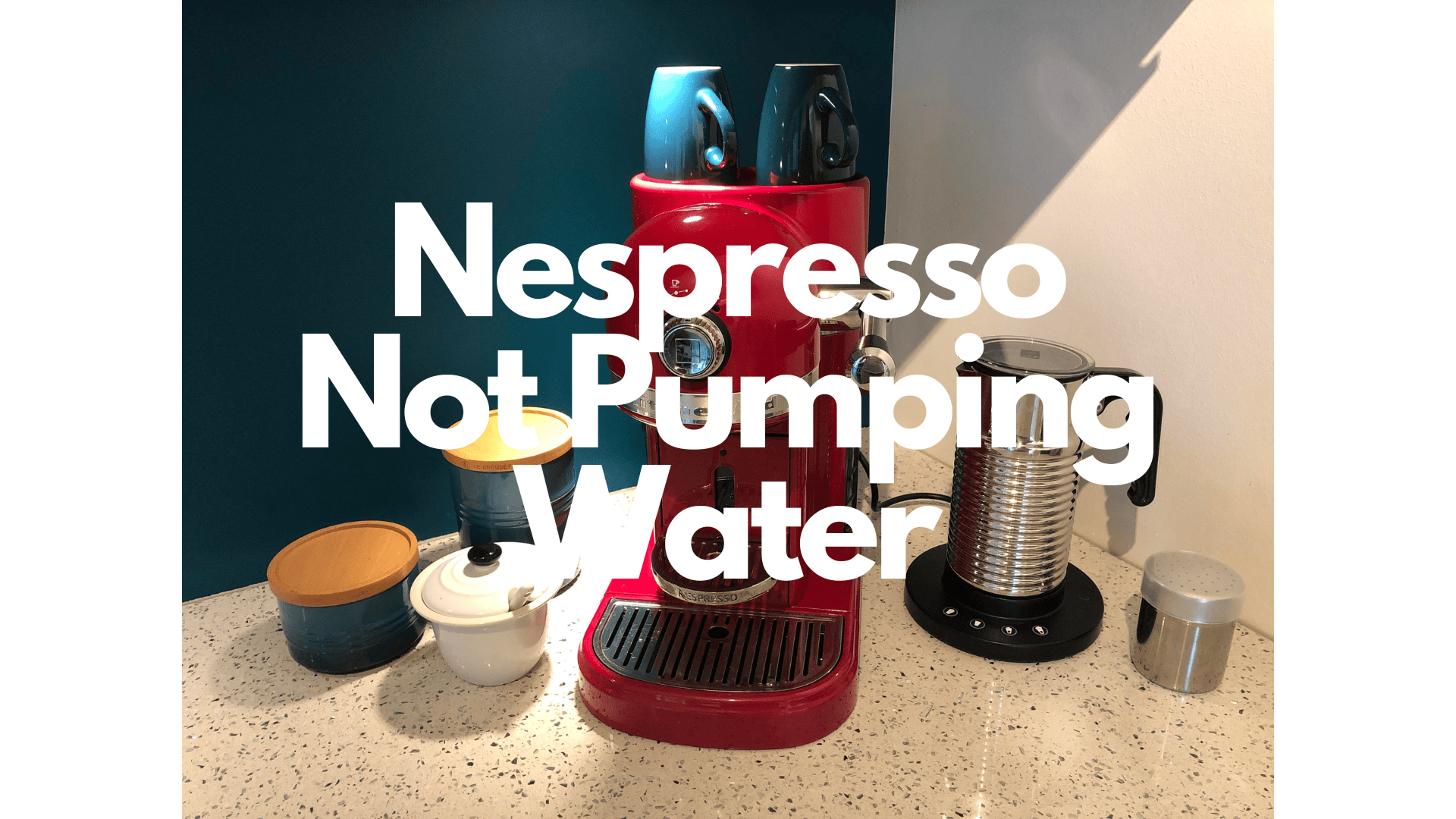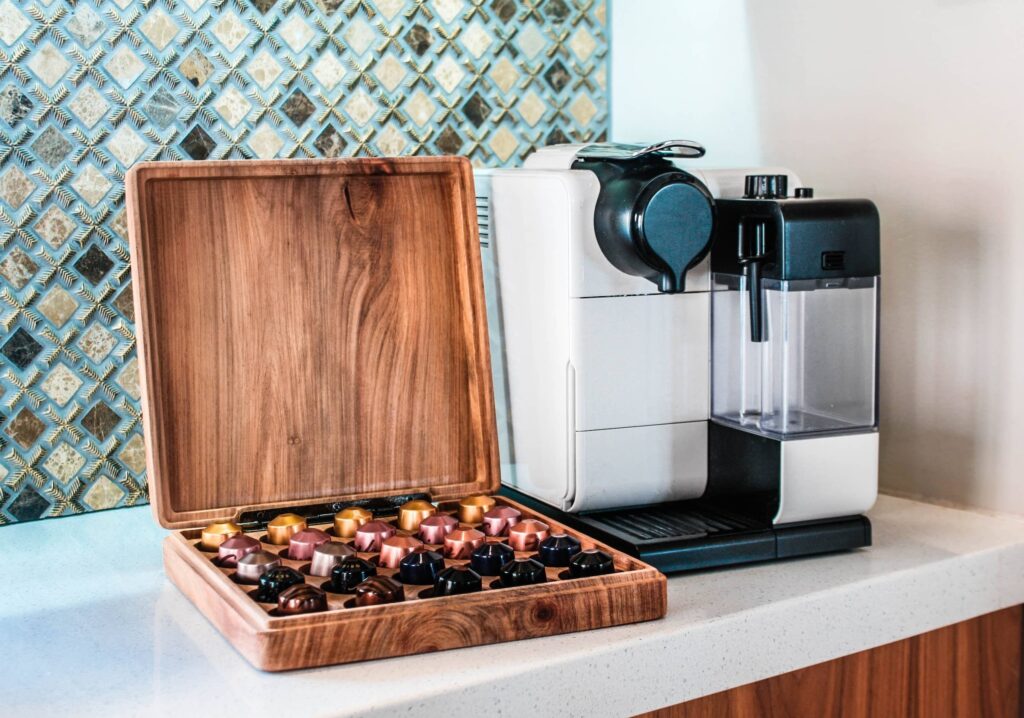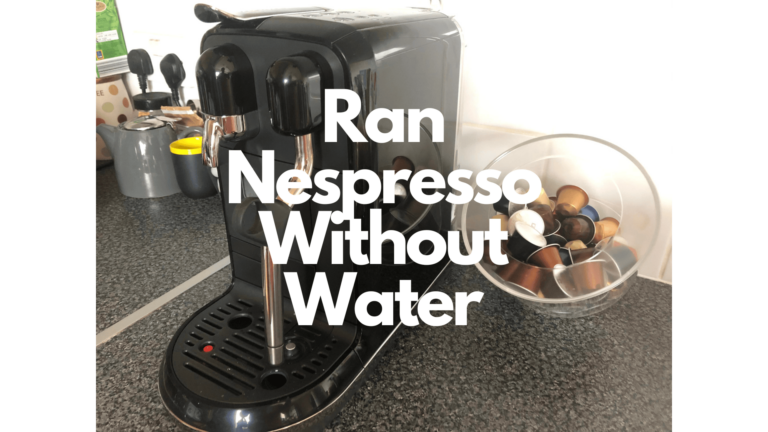Nespresso Machine Won’t Pump Water | 6 Quick Fixes

As a Nespresso machine owner, you know how valuable that first cup of coffee in the morning can be.
So if one day you wake up planning on some coffee and your trusted machine doesn’t pump any water, it can be pretty frustrating. A hiccup like this can disrupt your routine for as long as the coffee maker doesn’t work, so it’s important to get it fixed fast.
However, before you rush off to the repair shop or start shopping for a new machine, it’s essential to know that many common Nespresso machine issues, including water pump failures, can be solved easily at home.
So what is going on if your Nespresso machine doesn’t pump water?
If a Nespresso machine isn’t pumping water it likely has an airbubble or airlock. An airlock can be created when a Nespresso is run without water in the water tank or the machine sits in storage for an extended period of time. There are various methods that can be used to remove an airlock such as the plastic bag method, infant syringe method, and water tank method.
In this article, we’ll explain why your Nespresso machine isn’t pumping water and then give you 6 different methods you can use to fix the issue quick and get your coffee maker back in business.
Why Your Nespresso Machine Won’t Pump Water
Your Nespresso machine might not be pumping water for several reasons. Some of the most common include issues with:
- The water tank not being properly attached
. - A problem with the water pump
. - A blocked or dirty capsule container
. - A glitch in the machine’s software.
Oftentimes, it’s the result of an airlock, where air trapped within the machine’s water system prevents it from pumping water.
Learn how to open a jammed Nespresso machine here.
What is an Air Lock?
An airlock or air bubble is essentially a blockage in your machine’s water system that is caused by trapped air. In the context of a Nespresso machine, an airlock happens when the system that pumps water through the machine gets filled with air. This air pocket creates a barrier or “lock” that stops water from flowing through the system as it should.
While an airlock can seem like a serious issue, the good news is that it’s generally easy to resolve. By following some simple troubleshooting steps, you can typically fix an airlock issue and get your machine back up and running.
2 Main Causes of Airlocks
1. Running the Nespresso Machine Without Water
When you run the machine without any water in the tank, it’s like when you try to suck up the end of a milkshake with a straw when there’s nothing left. The machine tries to draw in liquid where there is none and ends up sucking in air instead.
This air then gets trapped inside the machine’s internal water system, causing an airlock. As a result, the next time you try to use your machine with water, it may struggle to pump it through effectively due to this air blockage.
2. The Machine Sits Unused for an Extended Period
If you don’t use your Nespresso machine for an extended period, say a year or more, it’s possible for air to gradually seep into the water system, leading to an airlock. This can happen as the water originally in the system slowly evaporates or as normal ambient air pressure changes, allowing air to fill the water lines.
When you eventually come back to your machine and try to use it after this long time, you may find that it can’t pump water properly because of this air blockage.
Related: Find out if you can use Keurig Pods in a Nespresso in our article here.
6 Different Ways To Remove a Nespresso Airlock


An airlock may seem like a huge, complex problem, but fortunately, there are several methods you can use to fix it.
If you’re like me and not mechanically-gifted, no worries. These fixes are simple things that anyone can do.
1. Nespresso Official Method
First up is Nespresso’s official method to get rid of the airlock. To start, brew a lungo without a pod in place and open and close the capsule lid repeatedly to encourage the airlock to move. If you have Le Cube or Essenza machines, you want to lift the coffee lever and move it away from you. Keep applying the pressure and push one of the cup buttons until the water starts flowing in the capsule chamber.
Lattissima, Pixie, and CitiZ model owners can fill the water tank, remove any capsules if they’re in the chamber, close the coffee lever, and then push the button to brew a large cup of coffee. The machine’s auto-prime function will force the air out of the circuit, and water will start to flow once it releases the air bubble.
Finally, if you have a Nespresso with a stealth arm, like the D290 Concept, you should activate the hot water or steam function. The lower pressure the machine produces on this setting will ease the air bubble out.
Related: Have you ever descaled your Nespresso? Cleaning it regularly is a must to avoid hard water buildup and problems with airlocks.
2. Ziploc Bag Method
Next up is the ziplock bag method. It takes roughly 20 seconds from start to finish, and all you need is a ziplock bag. Start by trapping air into the bag and seal it shut.
Stuff the inflated sealed bag into your empty water reservoir to get a tight fit. Make sure you get the whole bag inside of the reservoir, and then push from the middle to create outward pressure. To finish, close the reservoir with the bag inside, turn the system on, and run it. The above video is a helpful resource to follow.
3. Infant Medicine Syringe Method
If your water reservoir is an odd shape and you can’t get a ziplock bag inside to get a good seal, this method may work. Start by locating the water suction port on the back of your Nespresso machine where the water reservoir sits. Get a pair of needle nose pliers and carefully pull the strainer out.
Get your infant syringe and fill it with water. Stick the end into the port and carefully push down on the plunger to force the water into the tubing. This will push out the air bubble. You may have to repeat this process two or three times before replacing the strainer, filling your reservoir with water, plugging it back in, and starting your Nespresso.
4. Water Tank Method
If none of the above methods have worked, another that has been successful for some is the water tank method.
Fill your reservoir with water and press the brew button to brew a big cup of coffee. As it starts, remove the water reservoir for a few seconds and put it back on while keeping the Nespresso running. This pumps air back into the water container and pushes the airlock out. You may need to do this a few times until it starts running. Run the water through a few times until it comes out clear.
Another option you have is if you do the same process I described in the previous paragraph, but don’t remove the water reservoir completely. Instead, gently rock it back and forth, barely removing it from the pump portion. You should start to see air bubbles escaping, and it’ll start to run once all of the air is out.
5. Flexible Tubing Method
Another method for air bubble removal involves using some flexible tubing. This method is very similar to the infant syringe. To start, remove your water reservoir to expose the water intake port. Get a flexible piece of tubing that fits into this port, and a small squirt bottle filled with water.
Put one end up to the port, making sure you get a good seal. Pour a small amount of water into the tubing and gently blow into the other end to force the water into the tubing. You may see water start to gurgle when you remove the tubing. If so, you can put the water reservoir back, fill it, and run a cycle.
6. Nespresso Purging Method
The final tip is a fix from Reddit that worked for some Nespresso owners:
- Turn your Nespresso off
- Remove your water tank and close the lever. Put a container under your coffee outlet to catch the water.
- Press and hold your machine’s Espresso button and turn it on. Wait until you don’t see more water coming out. The machine will switch off automatically and purge any stuck air.
However, if you put the water tank back on and find that your Nespresso won’t stay on, there is another step to try. You want to exit the descaling mode. To do so, press both buttons at the same time for one second. This should get your Nespresso back on and ready to use.
Final Thoughts
A Nespresso machine that won’t pump water can cause more than a few hiccups in your daily routine. But remember, it’s not the end of the world. Many times, the problem can be resolved easily at home with some basic troubleshooting techniques.
As coffee lovers, we know how critical that first cup of joe is to starting your day right. Armed with these tips and tricks, you’re now well-equipped to troubleshoot and revive your Nespresso machine, ensuring it continues to serve up delicious, energizing espressos. After all, no one wants to stand between you and your much-needed coffee fix!


